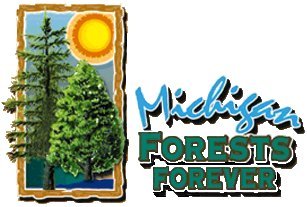

Home Page |
MICHIGAN FORESTS FOREVER TEACHERS GUIDE
| THE FOUR 'Rs' |  |
        |
Many of Michigan's fourth and fifth graders
learn the "reduce-reuse-recycle" message. However, wood use has a fourth
"R" . . . called "renew". The renewability
aspect may very well be the best feature of wood use.
Even an unmanaged forest will regenerate after timber harvest. Northern temperate forests have an amazing resiliency and ability to recover. Just look at our bountiful forests today! They are well on their way to recovery from the massive logging era around the turn of the last century. Of course, forest management and generations of foresters have done much to nurture forest development. The series of photos to the left was taken from nearly the same place for almost a century. By 1911, a typical forest scene was of cut-over land, usually burned-over as well. By 1928, many of our federal, state, county, and industrial forests were forming. Huge planting and fire protection efforts were initiated (see Forest History). As forests recovered, management began across much of the new landscape. Markets and industries developed to utilize the new forests. On managed forest, the recovery progressed much sooner. These days, most of us have forgotten how foresters and nature have worked together to bring about the condition that we enjoy and benefit from today. But forest management is more important today than ever before. Part of renewability involves the ability of the forests in a particular region to respond to management and our ability and skill in managing these forests. Here in Michigan, and throughout the Lake States, we are fortunate to have exceptionally resilient forests and a long history of forest management. Because of these factors, one could argue that our forests should be actively managed to produce more of the many outputs they are capable of, especially timber. The renewability strength might allow more sensitive forest areas in our region and in other regions of the world to be managed less intensively, or maybe not at all. Dr. Bruce Sohngren, of Ohio State University, produced a model that suggests that for every 20 acres of productive forest "reserved" in the USA, one acre of forest is harvested somewhere else. Much of the "somewhere else" is likely to be in lesser developed countries with fewer (if any) environmental protection laws. It is the tropical rainforests that are most threatened these days. So, thinking globally and acting locally can involve increased management of our Michigan forests. Besides the aspect of renewability, many wood products can also be reused and recycled. Of course, we can also reduce consumption of wood products, but not by replacing wood products with items made from plastic, metals, or other kinds of raw materials. Nothing beats wood in terms of being light on the environment (see essays by Bowyer and Moore). Actually, we should probably be using more wood by replacing those items made out of other materials, at least where it makes sense to do so. Using paper cups and plates, for example, would be better than using plastic or Styrofoam cups and plates, especially from a carbon and climate change perspective. Arguably, Lake States forests have much untapped potential to produce greater quantities of timber and fiber with many positive outcomes. Michigan forests are producing nearly twice the volume of wood that we have been harvesting, and the number of forest acres in Michigan is on the rise (see Michigan Forest Descriptors). Many recycling efforts are ongoing in Michigan communities. However, we need to keep in mind that many products, especially paper products, cannot be made exclusively from recycled fibers, and fibers can only be recycled a few times before they are worn out. But mixing recycled and new fibers, when possible, is a good way to conserve forest resources. Over 45 million tons of paper are recycled each year. Recycling also helps reduce the flow of solid waste, where paper still occupies much of our landfill space. For more information about paper recycling, paper making, and the paper industry, "Two Sides" has a good website. Recycling of solid wood is another matter, and more difficult. Only about five percent of the solid wood waste generated by U.S. communities is recycled or recovered. Most solid wood waste comes from sources like demolitions, pallets, and storm clean-up. Within the primary wood-using industries, however, over 90 percent of the "waste" is utilized. For more about solid wood recycling, and other topics, try the AF&PA website. The “WoodLINKS” program is a highly regarded curriculum about wood products. |
| Activity Suggestion PLT Resource-Go-Round PLT Reduce Reuse Recycle |
 |
This website was developed and created by Michigan State University Extension for the teachers of the State of Michigan. |